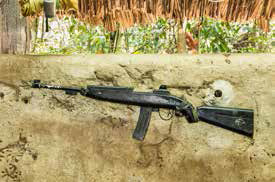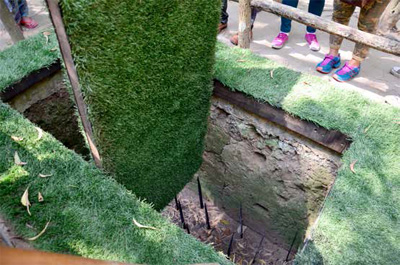VIETNAM’S CU CHI TUNNELS attest to the extraordinary resourcefulness and resilience of a group of Southern Vietnamese people, known as the Viet Cong, during their struggle to fight and survive the Vietnam War. Located just outside Ho Chi Minh City in the region of Cu Chi, the tunnels enabled the Viet Cong to survive underground during this historic conflict which broke out in 1954, pitting the Communist Viet Minh party of North Vietnam and its southern allies, known as the Viet Cong, against the non- Communist faction of South Vietnam and its main ally, the United States.
Two sites — Ben Dinh and Ben Duoc — allow visitors to view and even crawl through the tunnels, which the Communist forces built over the course of 20 years. To view either one, the easiest method is to have your hotel arrange a tour out of Ho Chi Minh City. You can be picked up at your hotel, taken to the site and returned later that day — the tunnels lie about 20 and 30 miles outside of Ho Chi Minh City. You’ll want to wear clothes you don’t mind getting dirty.

Rifle exposed in the Cu Chi tunnel park © MIRKO VITALI | DREAMSTIME.COM
Because the tunnels of Ben Dinh lie closer to Ho Chi Minh City, they’re the most popular to visit. Your guided tour begins with a short film explaining the historical background of the tunnels. It’s worth knowing before you get down on your hands and knees that the original region of Cu Chi was thick with rubber plantations supplying a French tire company. Apparently, the area’s first tunnels were dug in the 1940s by the anti-colonial Viet Minh to store their arms during their struggle for independence from the French. The Viet Cong greatly expanded the network, easily dug from the area’s compacted red clay. However, as you’ll learn from your guide (or supplementary reading), all the ceilings of the tunnels had to be reinforced, ideally with wood. But since American bombing of the area reduced the availability of timber, the Viet Cong ended up using iron fence posts from enemy bases.
Within the multistory tunnels — some were four levels deep — the Viet Cong lived for weeks, even years. The tunnels had sleeping quarters, meeting rooms, schools, kitchens, wells and latrines, as well as makeshift hospitals. Surgeons operated by torch light using rudimentary instruments, and a patient’s own blood was deposited in a bottle and then pumped back into the body using a bicycle pump and rubber hosing.
Although the tunnels had vent shafts to disperse cooking smoke, not surprisingly the passages could become extremely hot and foul-smelling. Inhabitants also had to fight off bats, snakes, scorpions, centipedes and fire ants. The Viet Cong used some of these creatures as weapons, setting up boxes of scorpions and hollow bamboo sticks filled with vipers in areas of the tunnels the enemy (mainly American forces) might enter. Flooding in the tunnels was a constant risk, as was disease, particularly malaria. Hidden trap doors provided release points for the inhabitants, who would leave the tunnels to fight and hunt for food (mainly roots and leaves, since American chemical weapons and bombs destroyed most of the Viet Cong’s rice paddies and fruit crops). After an attack, the Vietnamese fighters disappeared into the tunnels, eluding their American enemy. The Viet Cong not only used the tunnels as living quarters but also as hideouts and routes to transport communications and supplies. For tunnel inhabitants who stayed underground for extended amounts of time, the darkness was so intense, when they finally exited they suffered temporary blindness.

A booby trap with bamboo spikes at the tunnels © TUAYAI | DREAMSTIME.COM
American soldiers knew about the tunnels and tried to flush out the enemy. In addition to using bulldozers and defoliant sprays, American soldiers crawled down into the tunnels with hand grenades or gas bombs. The tunnels, however, were often so low and narrow American soldiers could not get down them, let alone scurry through them. Indeed, as you make your way through the labyrinth of dirt passageways (many of which have been widened to accommodate the larger girth of visiting tourists), you’ll sense immediately how dark, dirty and claustrophobic they feel, even after only 10 minutes. As you might imagine, the tunnels open to visitors only represent a fraction of the 155-mile-long and 30-mile-wide network.
More than 3 million people perished during the war; half were Vietnamese civilians. In 1973 President Richard Nixon ordered the withdrawal of U.S. troops from Vietnam. In 1975 the war ended when Communist forces took control of Saigon (now Ho Chi Minh City) and renamed the country the Socialist Republic of Vietnam the following year.
Years after the war, the Vietnamese government created a war memorial park that included the Cu Chi tunnels, where more than 45,000 Vietnamese were said to have died. In 1982 the Vietnam Veterans Memorial opened to the public in Washington, D.C., inscribed with the 57,939 names of American armed forces killed or missing during the war.
Info to Go
Many airlines fly daily from the United States to Vietnam, including Korean Air, Cathay Pacific and American Airlines. Ho Chi Minh City’s Tan Son Nhat Airport (SGN) lies approximately 20 minutes by car outside the city center, and regulated taxis remain the most reliable, convenient and popular form of transportation to get you to your hotel. Alternatively, you can arrange in advance with your hotel to have a car meet you at the airport.
Read This Next
All Reads on This Topic
Read Them All

Introducing
FX Excursions
FX Excursions offers the chance for once-in-a-lifetime experiences in destinations around the world.
#globility
Insta FeedDaily
May 10, 2024World’s First Chief Aurora Chaser Joins Hurtigruten
In the world of professional titles, not much beats a business card that bears the stamp Chief Aurora Chaser. Northern Lights astronomer, author and speaker Tom Kerss has been bestowed with exactly that designation thanks to a new partnership with Hurtigruten.
Sponsored Content
Exclusive Savings: Cruise Along the Danube River with Global Traveler
Exclusive Sailing with Global Traveler
May 2024
May 10, 2024Global Traveler Announces the Winners of the 2024 Leisure Lifestyle Awards
With hearty congratulations we are delighted to bring you the 12th Leisure Lifestyle Awards winners! Our annual survey honors the best in the world of leisure and lifestyle travel, awarding goods, services, destinations, hotels, airlines, airports, cruises and more. Read on to find out who dominates in the leisure travel industry, and see if your favorites made the cut. We also offer a hearty thank you to our readers, the most seasoned travelers we know, for voting in this year’s survey.
Leisure Lifestyle 2024
May 10, 2024Enjoy a Private Island Retreat, Accessible Only by Cruise Ship
Setting sail on a cruise is, for the most part, an all-inclusive experience, providing myriad opportunities for traveling someplace new and exotic. More than a dozen cruise lines sweeten tropical itineraries by calling upon their own private islands, giving guests exclusive access to uninterrupted stretches of sandy beaches and calm waters. Here we take a look at some of the private islands to which it’s worth charting a course.
Sponsored Content
Unearth Seoul’s Hidden Gems
Filled with hidden treasures waiting to be discovered, Seoul invites travelers to unearth its many gems, and Seoul Tourism Organization is here to help travelers do just that. Through thoughtfully created initiatives like the Theme Tourism County Competition, Seoul Tourism Organization works closely with local districts to identify and showcase what makes each district unique and charming in all seasons.
Daily
May 10, 2024Take Part in InterContinental New York Barclay’s Summer Programming
InterContinental New York Barclay Hotel unveiled new programming for summer travelers, inviting guests to partake in experiences both in and out of the hotel. The historic hotel is located just steps from Grand Central Station and serves as the perfect home base for a summer vacation to NYC.
5 NYC Hotels Going Big for Pride Month
Daily
May 9, 2024The Evolution of Boston’s Buzziest Bites
Daily
May 9, 2024Daily
May 8, 2024Doors Open in Edinburgh at Red Carnation’s 100 Princes Street
Leisurely afternoon tea flavored with castle views? You’ll enjoy this and plenty more at 100 Princes Street, Red Carnation’s newest property in Scotland’s fascinating capital city. Set within a historic structure that once served as headquarters for the Royal Overseas League, this luxurious hotel promises to both pamper guests and immerse them in a truly Scottish experience.
Sponsored Content
The Argosaronic Islands Are Calling
The Saronic or Argo Saronic Islands of Greece call travelers to explore its seven small islands and islets brimming with history, natural sites and more. With most easily accessible by boat, the islands’ proximity to ports of Athens make the Saronic Islands an ideal destination for those preferring shorter boat rides. In fact, trips from Athens ports to the islands take only between 10 minutes and two hours, depending on the island you choose, making them perfect for day or weekend trips. From Piraeus port, you can access Hydra, Spetses, Aegina and Poros directly. Come explore these stunning islands with us and find the inspiration to plan your next trip to these islands. Hydra Hydra town curves around a slope overlooking the Argosaronic Gulf like an amphitheater and is considered one of the most romantic destinations in Greece. Most unique to the island is its lack of vehicles. People on the island get around on mules and donkeys as well as water taxis, making for a peaceful and laid-back day. Hydra lies a two-hour ferry ride from Piraeus port in Athens.
Daily
May 8, 2024What are the World’s 50 Best Beaches in 2024?
Did your favorite beach make this year’s list? The World’s 50 Best Beaches was just released, showcasing the results of votes from more than 1,000 of the world’s most prominent travel professionals.
ShareThis